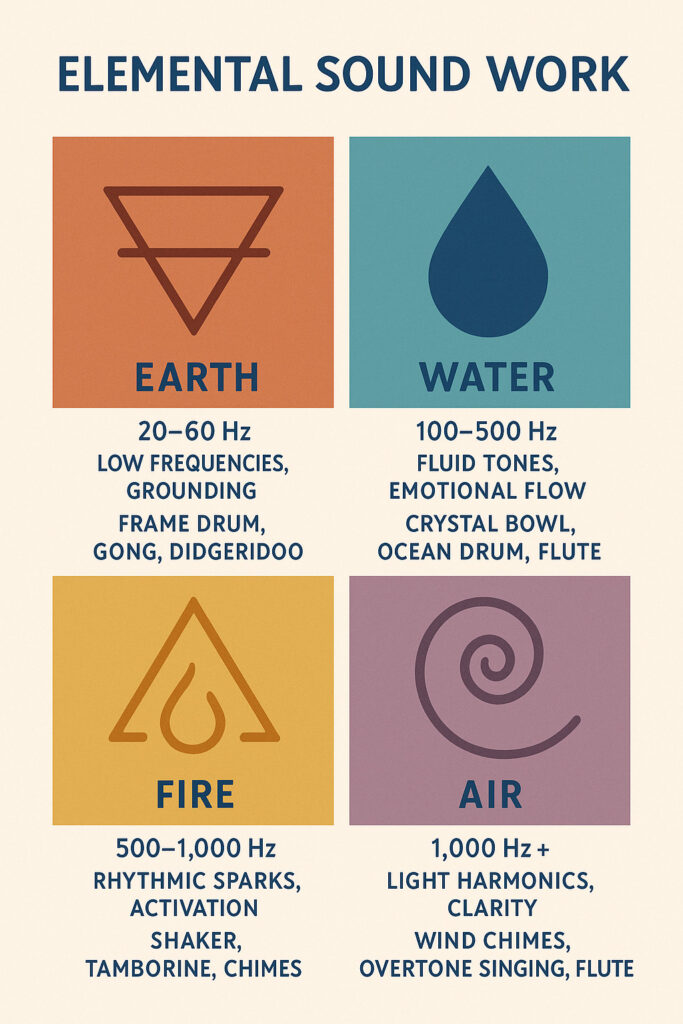Elemental Sound Work — Using Earth, Water, Fire, and Air Frequencies
For thousands of years, cultures around the world have linked sound to the forces of nature. In Elemental Sound Work, we connect with the four classical elements — Earth, Water, Fire, and Air — through specific tones, rhythms, and instruments that reflect their qualities. This approach engages not only our imagination and energetic body but also the physical mechanisms through which vibration affects our tissues, breath, and nervous system.

Why Work with Elements in Sound Healing?
Each element represents a set of physical sensations, emotional states, and frequencies that can be mirrored in sound. When we consciously evoke these elements, we:
- Activate different parts of our nervous system
- Engage specific muscle and breath patterns
- Influence the fascia and organ systems in distinct ways
- Align our energy with natural cycles and archetypes
The Four Elements in Sound Work
1. Earth — Low Frequencies for Grounding
Frequency range: 20–60 Hz
Sound qualities: Deep, steady, resonant
Instruments: Frame drum, bass drum, low didgeridoo, large gong, deep handpan notes
Physiology: Low frequencies travel efficiently through dense tissues and bones, stimulating proprioceptors and calming the nervous system. They can reduce muscle tension and help regulate heart rate.
Energy: Connects to the root chakra, grounding your energy, creating stability and presence.
Practice: Sit or lie down with a deep drum beat at a slow tempo (around 40–60 bpm). Feel the vibrations in your hips, legs, and spine.
2. Water — Fluid Tones for Emotional Flow
Frequency range: 100–500 Hz (gentle oscillations)
Sound qualities: Smooth, flowing, wave-like
Instruments: Crystal bowls with gliding tones, ocean drum, overtone flute, rainstick
Physiology: Mid-range frequencies resonate strongly with soft tissues and fascia, encouraging hydration and mobility in connective tissue. They can also stimulate the parasympathetic system, reducing stress hormones.
Energy: Opens the sacral chakra, supporting emotional release, sensuality, and adaptability.
Practice: Play a crystal bowl with a slow, circular motion, imagining sound waves washing through your body like tides.
3. Fire — Rhythmic Sparks for Activation
Frequency range: 500–1,000 Hz with dynamic rhythm
Sound qualities: Bright, sharp, energizing
Instruments: Shakers, tambourines, chimes, high-pitched singing bowls, clapping
Physiology: Higher frequencies and fast rhythms activate the sympathetic nervous system, increasing alertness, stimulating blood flow, and enhancing reaction time.
Energy: Relates to the solar plexus chakra, fueling willpower, creativity, and transformation.
Practice: Use a shaker or tambourine to create fast, syncopated rhythms while focusing on your breath quickening with the beat.
4. Air — Light Harmonics for Clarity
Frequency range: 1,000 Hz and above
Sound qualities: Whispery, airy, expansive
Instruments: Wind chimes, overtone singing, whistles, bamboo flutes
Physiology: High frequencies stimulate the auditory nerve and brain activity in areas linked to focus and mental clarity. They can also encourage deeper breathing when paired with wind instruments.
Energy: Connects to the heart and throat chakras, opening space for communication, compassion, and inspiration.
Practice: Stand outdoors with wind chimes or a flute, letting the sound blend with the ambient air to create a meditative atmosphere.
Integrating the Elements
A full Elemental Sound Work session can move through Earth → Water → Fire → Air, starting with grounding and moving toward expansion. This sequence mirrors the body’s natural awakening cycle: from deep rest, to emotional flow, to active engagement, to inspired clarity.
Conclusion
Elemental Sound Work bridges ancient symbolism with modern understanding of vibration and physiology. By matching frequencies and rhythms to the qualities of Earth, Water, Fire, and Air, we can tune our bodies and minds to the cycles of nature — restoring balance, focus, and vitality.
